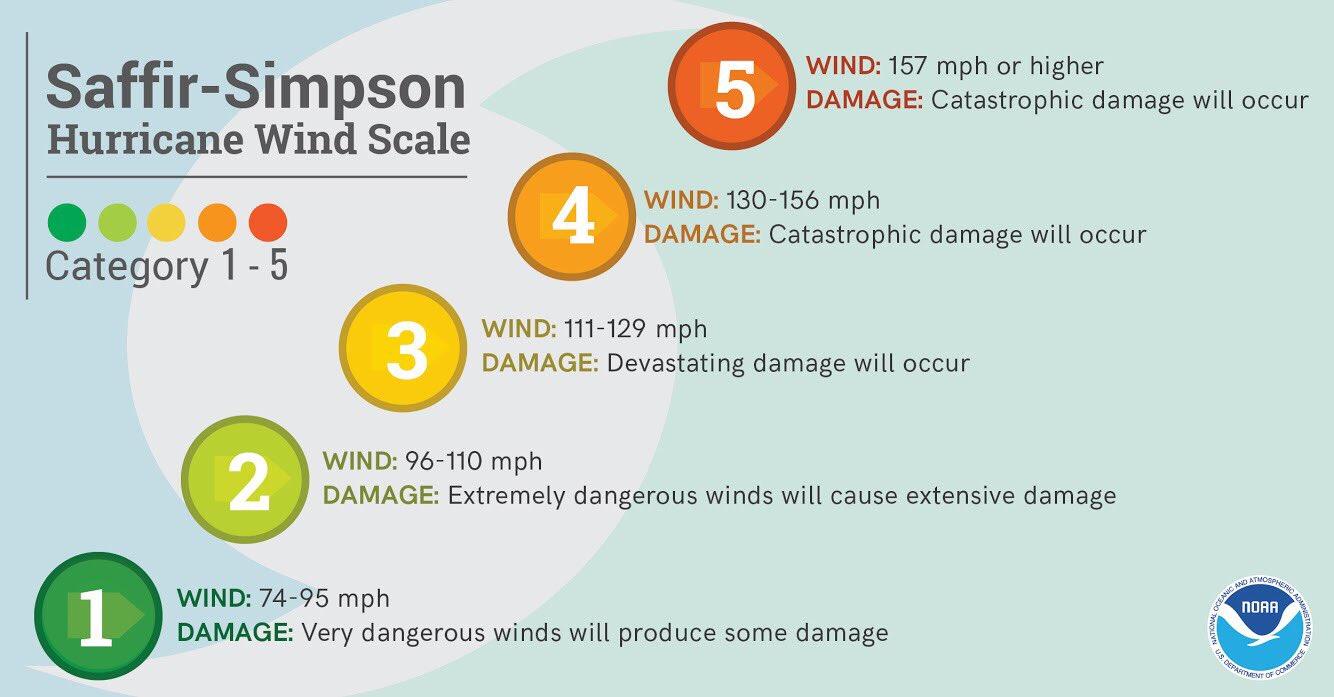Introduction
The strength of hurricanes is primarily determined by wind speed. The wind speed is ranked on a scale called the Saffir-Simpson Hurricane Wind Scale. Depending on the speed of the wind, a hurricane can be classified as a number between 1 and 5. However, what most people do not know is that wind speed is actually not the most destructive aspect of a hurricane. Some of the other deadly aspects of a hurricane include storm surge, heavy rainfall, rip currents, and tornadoes. This blog post will explore some of those impacts as well as go more into depth about the Saffir-Simpson Hurricane Wind Scale.
The Saffir-Simpson Hurricane Wind Scale
The Saffir-Simpson Hurricane Wind Scale categorizes hurricanes by wind speed and rates the type of damage associated with each category. Category 1 hurricanes are associated with sustained winds ranging from 74 mph to 95 mph and produce minimal damage to homes. For example, homes could have damage to shingles and gutters, but nothing too extensive. Category 2 hurricanes are more serious and contain sustained winds from 96-110 mph. Extensive damage can occur with these hurricanes and homes can have damage to roofs and siding. Category 3 is even more destructive and has sustained winds fluctuating between 111 and 129 mph. Devastating damage to homes will occur with these hurricanes and frequently roof decking can be torn off, trees can be snapped or uprooted, and power outages are common. On the Saffir-Simpson Hurricane Scale, the most catastrophic damage begins with Category 4 hurricanes. These hurricanes have sustained winds ranging from 130-156 mph and homes can lose most of the roof structure or even be torn off their foundations. Finally, the most catastrophic of all of these hurricanes is the Category 5. Category 5 hurricanes pack sustained winds that exceed 157 mph and often destroy homes completely, take down power lines, and cause power outages that can last for weeks to months. Below is a chart that explains more about some of the impacts associated with each category storm.

Chickering, H. (2017, September 10). Hurricane Categories: Missing the Big
Picture? [Photograph]. Retrieved from https://www.bpr.org/post/
hurricane-categories-missing-big-picture-0#stream/0
Storm Surge
Arguably, storm surge and storm tide pose the greatest threat to life and property. Storm surge is the rise in the seawater level caused by hurricanes(NOAA, 2018). It is measured as the height of the water above sea level compared to the normal predicted astronomical tide(NOAA, 2018). Storm surge is extremely dangerous because the wind pushes large amounts of water onshore which can flood and destroy houses. The video below shows how destructive storm surge can be and how much force the water has when it hits land.
Hurricane Storm Surge [Video file]. (2015, May 28). Retrieved from youtube database.
Heavy Rainfall
Hurricanes often produce widespread, torrential rain that can exceed 6 inches(NOAA, 2018). This can result in deadly, destructive flooding especially when it is coupled with storm surge. Flash flooding is a byproduct of this rainfall and occurs from the rapid rise of water levels on streets(NOAA, 2018). Slower moving storms that stall over locations can dump a significant amount of rainfall over areas in a short period of time, which can result in people getting stranded on roadways and homes getting damaged.
Rip Currents
Although, rip currents cannot actually be seen, their impacts to mariners and swimmers are actually quite lethal. Rip currents are strong, narrow seaward flows of water that extend close to the shoreline out to sea(NWS, 2018). Essentially, they are channels of water that extend from the shoreline out to sea. They can pull the strongest swimmers farther offshore and are also a hazard for boaters. In fact, in 2009 6 deaths were attributed to rip currents from tropical cyclones(NOAA, 2018).
Tornadoes
Tornadoes can also be embedded in tropical cyclones, especially around the eyewall. Typically tornadoes are short-lived but they can cause a significant amount of damage in localized areas.
Conclusion/My Opinion
I think that the most dangerous aspect of a hurricane that can often be overlooked is the storm surge. These walls of water can wash away homes and cause significant flooding. Nonetheless, people need to be aware of the different aspects of hurricanes because they can be life-threatening.
References
Hurricane Preparedness- Hazards. (n.d.). Retrieved November 12, 2019, from
National Hurricane Center and Central Pacific Hurricane Center website:
https://www.nhc.noaa.gov/prepare/hazards.php
Rip Current Science. (n.d.). Retrieved November 12, 2019, from National Weather
Service website: https://www.weather.gov/safety/ripcurrent-science
Saffir-Simpson Hurricane Wind Scale. (n.d.). Retrieved November 12, 2019, from
National Hurricane Center and Central Pacific Hurricane Center website:
https://www.nhc.noaa.gov/aboutsshws.php
website: https://oceanservice.noaa.gov/facts/stormsurge-stormtide.html